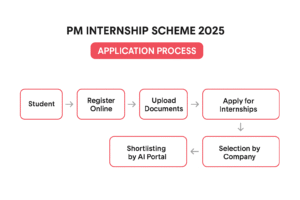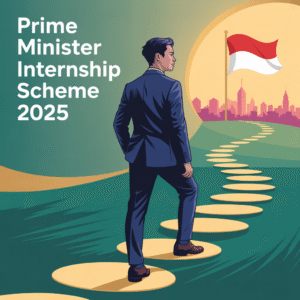Prime Minister Internship Scheme 2025 | Eligibility, Benefits & Analysis
Introduction
India stands at the threshold of a massive demographic shift. Nearly 65% of its population is below 35 years of age, making it one of the youngest countries in the world. While this youthful population offers opportunities for innovation and growth, it also poses challenges—especially around employment, employability, and industry readiness.
One of the biggest criticisms of the Indian education system is the gap between theoretical knowledge and practical exposure. Graduates often struggle to find employment, not because they lack degrees, but because they lack skills demanded by industries. Recognizing this, the Government of India launched the Prime Minister’s Internship Scheme (PMIS) in 2024.
With an ambitious target of providing 1 crore internships in five years, PMIS is a bold step to bridge the divide between classrooms and workplaces.
In this blog, we will do a deep-dive analysis of PMIS, covering:
-
Origins and Objectives
-
Eligibility and Structure
-
Financial Benefits
-
Application Process
-
Industry Participation
-
Real-World Impact
-
Criticism & Challenges
-
Comparative Perspective
-
Future Roadmap

1. Genesis of the Prime Minister’s Internship Scheme
-
Launch Date: Announced in the Union Budget 2024–25.
-
Implementing Ministry: Ministry of Corporate Affairs (MCA), Government of India.
-
Vision: To provide structured internship opportunities to young Indians, especially those from non-elite educational institutions.
-
Target: 1 crore internships in 5 years, making it the largest internship program in India’s history.
-
Budget Allocation: Around ₹2,000 crore was earmarked for the initial year.
Core Objectives
-
Address the problem of educated unemployment.
-
Provide hands-on exposure in India’s top 500 companies.
-
Empower students from disadvantaged backgrounds by making internships inclusive.
-
Strengthen the industry–academia linkage.
-
Make youth job-ready and enhance employability skills.
2. Eligibility Criteria
Unlike traditional internships where only top students from IITs/IIMs/elite universities are selected, PMIS focuses on wider inclusion.
-
Age: 21–24 years.
-
Educational Background:
-
10th pass
-
12th pass
-
ITI or Polytechnic diploma holders
-
General graduation (BA, B.Sc, B.Com, etc.)
-
-
Income Limit: Family income must be below ₹8 lakh per year.
-
Exclusions: Students of IITs, IIMs, NITs, AIIMS, NLUs, IIITs, and professional degrees like MBA, CA, MBBS, PhD are not eligible.
-
Employment Status: Applicants should not be in full-time employment.
👉 Why such restrictions?
The scheme is designed to uplift underrepresented youth, not those who already have access to premier placements.

3. Structure of the Internship
-
Duration: 12 months (with at least 6 months dedicated to job-related tasks).
-
Mode: Primarily offline internships in company offices/factories.
-
Sectors Covered: Over 24 key sectors including:
-
Information Technology (IT)
-
Manufacturing & Engineering
-
Banking & Finance
-
Retail & FMCG
-
Healthcare & Pharmaceuticals
-
Agriculture & Food Processing
-
Energy, Infrastructure & Transport
-
Participating Companies
The scheme involves India’s top 500 companies. Some notable names:
-
TCS
-
Infosys
-
Maruti Suzuki
-
Reliance Industries
-
HDFC Bank
-
ONGC
-
L&T
-
Jubilant Foodworks
This ensures that youth gain exposure to industry leaders, enhancing credibility of their experience.
4. Financial Benefits
A major attraction of PMIS is the stipend and support system provided to interns:
-
Monthly Stipend: ₹5,000
-
₹4,500 from Government (DBT to student’s bank account).
-
₹500 from Company’s CSR funds.
-
-
One-time Grant: ₹6,000 for travel, accommodation, or initial expenses.
-
Insurance: Free coverage under:
-
Pradhan Mantri Jeevan Jyoti Bima Yojana (Life Insurance).
-
Pradhan Mantri Suraksha Bima Yojana (Accident Insurance).
-
-
CSR Benefits for Companies: Firms can allocate up to 5% of their CSR budget for administrative costs of internships.
👉 Compared to unpaid or low-paid internships in private sectors, this makes PMIS more accessible to economically weaker youth.
5. Application Process
The entire application process is digital, making it transparent and efficient.
Step-by-Step Process
-
Registration:
-
Visit official portal pminternship.mca.gov.in.
-
Aadhaar-based verification and KYC authentication.
-
-
Profile Creation:
-
Upload documents (ID, educational certificates, income certificate).
-
Choose sector preferences.
-
-
Application:
-
Apply for up to 3–5 internships at once.
-
-
Shortlisting:
-
AI-driven system ensures fair representation of SC, ST, OBC, PwD, and women candidates.
-
-
Selection:
-
Companies select interns based on merit and requirement.
-
-
Joining & Tracking:
-
Mobile app + online dashboard helps track internship status, attendance, stipend disbursement.
-
📊 Flowchart Representation (text form):

6. Progress So Far
Pilot Phase (2024)
-
Launched on October 3, 2024.
-
127,000 internship positions offered by 280 companies.
-
620,000 students applied.
-
82,000 were selected, but only 8,700 joined.
👉 Conversion Rate = 10.6% (very low).
Second Phase (Jan 2025)
-
118,000+ internships across 327 companies.
-
Applications open till March 2025.
Challenges in Pilot
-
Low stipend perception.
-
Lack of clarity about job roles.
-
Distance/location issues.
-
Dropouts due to mismatch between expectation vs reality.
7. Success Stories & Case Studies
Case 1: ITI Student in Pune
-
Joined Maruti Suzuki plant.
-
Learned real-world automotive technology.
-
After 1 year, received a pre-placement offer.
Case 2: BA Graduate in Bihar
-
Internship with HDFC Bank in rural financial literacy project.
-
Exposure to digital banking & customer service.
-
Now working as a junior executive in a cooperative bank.
These cases show that while not all internships lead to jobs, many provide a career launchpad.
8. Comparative Perspective
India’s Other Internship Programs
-
AICTE Internship Portal: For engineering students.
-
TULIP Internship Program: Urban governance internships.
-
NITI Aayog’s Young Professional Program: Policy-oriented roles.
PMIS vs Others: PMIS is broader (covers all educational backgrounds, not just engineering or policy).
Global Models
-
Germany (Dual System): Apprenticeships linked with education.
-
USA (Summer Internships): Mostly corporate, unpaid or low-paid.
-
China: Government-supported vocational internships.
👉 PMIS combines Germany’s structured approach with India’s inclusivity focus.
9. Criticism & Challenges Of Prime Minister Internship Scheme 2025
-
Low Participation: Out of 1.27 lakh openings, only 8,700 joined.
-
Perception Issues: Students expect higher stipends or job guarantee.
-
Awareness Gap: Rural students unaware of the scheme.
-
Logistics: Relocation costs higher than stipend.
-
Industry Hesitation: Some companies reluctant to train freshers.
-
Limited Post-Internship Pathways: No guaranteed employment.
10. Opportunities & Way Forward
To make PMIS impactful:
-
Increase Stipend: Match industry standards (₹8,000–₹10,000/month).
-
Hybrid Internships: Allow remote/online modules for IT, marketing.
-
Awareness Drives: Promote via colleges, social media, NGOs.
-
Skill Mapping: Match students to industries based on aptitude.
-
Post-Internship Placement: Create a job portal exclusively for PMIS alumni.
-
Mentorship Programs: Industry mentors to guide interns.
11. The Future of PMIS
If implemented well, PMIS can:
-
Significantly reduce educated unemployment.
-
Help industries access low-cost skilled interns.
-
Build a pool of job-ready youth for India’s Make in India, Digital India, and Skill India missions.
-
Serve as a global model for inclusive internship programs.

Conclusion
The Prime Minister’s Internship Scheme (PMIS) is one of the most ambitious initiatives of India’s youth empowerment journey. It acknowledges that degrees alone do not create jobs—skills, exposure, and industry experience do.
While the pilot phases have exposed weaknesses (low conversion rates, perception issues, logistical challenges), these are teething troubles of a new program. With better outreach, improved stipend structures, and strong post-internship pathways, PMIS can become a game-changer in harnessing India’s demographic dividend.
Visit : https://aaopadhein.org/
Also read : MBA Job Opportunities in 2025 | Top Careers, Salaries & Future Trends
7 Unmissable Movies Starring Robert Downey Jr. You Must

[…] Also Read : Prime Minister Internship Scheme 2025 | Eligibility, Benefits & Analysis […]
[…] Prime Minister Internship Scheme 2025 | Eligibility, Benefits & Analysis […]